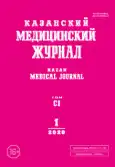Features of the dynamics of corticosteroid receptors in the myocardium of animals with different resistance to hypoxia in the post resuscitation period
- Authors: Bayburina GA1
-
Affiliations:
- Bashkir State Medical University
- Issue: Vol 101, No 1 (2020)
- Pages: 40-46
- Section: Experimental medicine
- URL: https://ogarev-online.ru/kazanmedj/article/view/17569
- DOI: https://doi.org/10.17816/KMJ2020-40
- ID: 17569
Cite item
Abstract
Aim. To characterize the peculiarities of the dynamics of the level of corticosteroid receptors in the myocardium of animals with different resistance to hypoxia in the post-resuscitation period.
Methods. Experimental studies were carried out on male non-inbred white rats, divided into 2 groups by hypoxia resistance. A 5-minute arrest of the systemic circulation was modeled under ether anesthesia with intrathoracic clamping of the cardiovascular cluster with subsequent resuscitation. The observation period was 35 days. The content of corticosterone and aldosterone was determined in the blood plasma, the concentration of glucocorticoid and mineralocorticoid receptors in myocard homogenates was determined as well.
Results. On days 1 to 3 of the post-resuscitation period in rats highly resistant to hypoxia, the dynamics of plasma corticosterone concentration and the content of corticosteroid receptors was unidirectional. Starting from the 5th day, against the background of a statistically significant decrease in the level of plasma corticosterone, a gradual increase in the density of corticosteroid receptors, mostly glucocorticoid, was observed, most pronounced on the 14th day and remaining until the end of the observation. In animals with low resistance to hypoxia, the dynamics of corticosteroid receptors was characterized by a predominance of mineralocorticoid content in almost all periods of observation. On days 1–3 of post-resuscitation period on the background of high concentrations of corticosteroid hormones, the minimum content of glucocorticoid receptors was noted. A decrease in the mineralocorticoid receptor level was recorded only on the first day, and in all subsequent periods of the experiment, the control indicators were significantly higher by 1.4–1.6 times. Strengthened mineralocorticoid signaling in the myocardium, characteristic of animals with low resistance to hypoxia, may be associated with the development of hypertrophy and fibrosis, inflammation, impaired electrical function. An increase in glucocorticoid receptors, characteristic of animals with a high resistance to hypoxia, has an adaptive effect, limiting the inflammatory response, the potential mechanism may be associated with increased expression of type 11β-hydroxysteroid dehydrogenase.
Conclusion. The identified features can have a significant influence on the course of the post-resuscitation period and determine the long-term forecast.
Full Text
##article.viewOnOriginalSite##About the authors
G A Bayburina
Bashkir State Medical University
Author for correspondence.
Email: gulnar.2014@mail.ru
ORCID iD: 0000-0002-4741-6295
Russian Federation, Ufa, Russia
References
- Dolgikh V.T., Govorova N.V., Orlov Yu.P. et al. Pathophysiological aspects of hyperoxia in anesthesiologist-reanimatologist's practice. Obshchaya reanimatologiya. 2017; 13 (3): 83–93. (In Russ.)
- Luk'yanova L.D. Dysregulation of aerobic energy metabolism — a typical pathological process. In: Dizregulyatsionnaya patologiya. (Dysregulation pathology.) Moscow: Meditsina. 2002; 188–215. (In Russ.)
- Sapolsky R.M., Romero L.M., Munck A.U. How do glucocorticoids influence stress responses? Integrating permissive, suppressive, stimulatory, and preparative actions. Endocr. Rev. 2000; 21 (1): 55–89. doi: 10.1210/edrv.21.1.0389.
- Gomez-Sanchez E. Brain mineralocorticoid receptors in cognition and cardiovascular homeostasis. Steroids. 2014; 91: 20–31. doi: 10.1016/j.steroids.2014.08.014.
- Chapman K., Holmes M., Seckl J. 11β-Hydroxysteroid dehydrogenases: intracellular gate-keepers of tissue glucocorticoid action. Physiol. Rev. 2013; 93 (3): 1139–1206. doi: 10.1152/physrev.00020.2012.
- Richardson R.V., Batchen E.J., Denvir M.A. et al. Cardiac GR and MR: from development to pathology. Trends Endocrinol. Metab. 2016; 27 (1): 35–43. doi: 10.1016/j.tem.2015.10.001.
- Bayburina G.A., Nurgaleeva E.A., Shibkova D.Z., Bashkatov S.A. The method for determining the degree of resistance to hypobaric hypoxia of small laboratory animals. Patent for invention N. 2563059 RF issued on 19.08.2015. Bulletin N. 26. (In Russ.)
- Korpachev V.G., Lysenkov S.P., Tell' L.Z. Simulation of clinical death and postresuscitation disease in rats. Patologicheskaya fiziologiya i eksperimental'naya terapiya. 1982; (3): 78–80. (In Russ.)
- John K., Marino J.S., Sanchez E.R., Hinds T.D.Jr. The glucocorticoid receptor: cause of or cure for obesity? Am. J. Physiol. Endocrinol. Metab. 2016; 310 (4): E249–E257. doi: 10.1152/ajpendo.00478.2015.
- Tokudome S., Sano M., Shinmura K. et al. Glucocorticoid protects rodent hearts from ischemia/reperfusion injury by activating lipocalin-type prostaglandin D synthase-derived PGD2 biosynthesis. J. Clin. Invest. 2009; 119 (6): 1477–1488. doi: 10.1172/JCI37413.
- Gray G.A., White C.I., Castellan R.F. et al. Getting to the heart of intracellular glucocorticoid regeneration: 11β-HSD1 in the myocardium. J. Mol. Endocrinol. 2017; 58 (1): R1–R13.
- Esteves C.L., Kelly V., Breton A. et al. Proinflammatory cytokine induction of 11betahydroxysteroid dehydrogenase type 1 (11betaHSD1) in human adipocytes is mediated by MEK, C/EBPbeta, and NF-kappaB/RelA. J. Clin. Endocrinol. Metab. 2014; 99 (1): E160–E168. doi: 10.1210/jc.2013-1708.
- Annane D., Pastores S.M., Arlt W. et al. Critical illness-related corticosteroid insufficiency (CIRCI): a narrative review from a Multispecialty Task Force of the Society of Critical Care Medicine (SCCM) and the European Society of Intensive Care Medicine (ESICM). Intensive Care Med. 2017; 43 (12): 1781–1792. doi: 10.1007/s00134-017-4914-x.
- Marzolla V., Armani A., Feraco A. et al. Mineralocorticoid receptor in adipocytes and macrophages: a promising target to fight metabolic syndrome. Steroids. 2014; 91: 46–53. doi: 10.1016/j.steroids.2014.05.001.
- Coutinho A.E., Campbell J.E., Fediuc S., Riddell M.C. Effect of voluntary exercise on peripheral tissue glucocorticoid receptor content and the expression and activity of 11β-HSD1 in the Syrian hamster. J. Appl. Physiol. 2006; 100 (5): 1483–1488. doi: 10.1152/japplphysiol.01236.2005.
- Ohtake M., Hattori T., Murase T. et al. Glucocorticoids activate cardiac mineralocorticoid receptors in adrenalectomized Dahl salt-sensitive rats. Nagoya J. Med. Sci. 2014; 76 (1–2): 59–72. PMID: 25129992.
- Takahashi K., Murase T., Takatsu M. et al. Roles of oxidative stress and the mineralocorticoid receptor in cardiac pathology in a rat model of metabolic syndrome. Nagoya J. Med. Sci. 2015; 77 (1–2): 275–289. PMID: 25797993.
- Oakley R.H., Cidlowski J.A. Glucocorticoid signaling in the heart: A cardiomyocyte perspective. J. Steroid Biochem. Mol. Biol. 2015; 153: 27–34. doi: 10.1016/j.jsbmb.2015.03.009.
- Young M.J., Rickard A.J. Mineralocorticoid receptors in the heart: lessons from cell-selective transgenic animals. J. Endocrinol. 2015; 224: R1–R13. doi: 10.1530/JOE-14-0471.
Supplementary files







